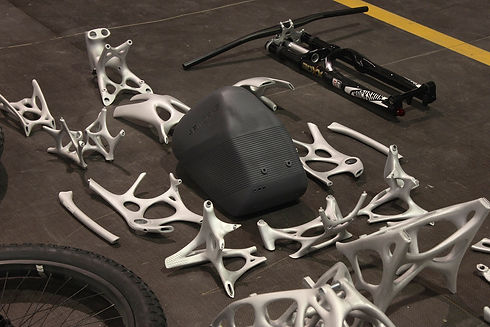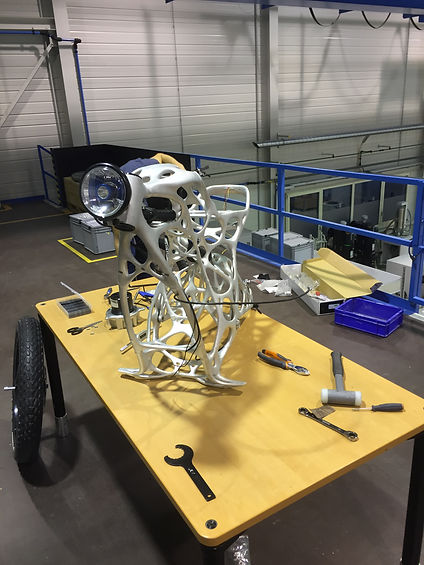

Journey of the Light Rider
Back in 2015, we embarked on an ambitious project. The goal of that project was primarily to show the world (and our prospective customers) what was possible with Additive Manufacturing, when properly combined with our high strength Scalmalloy material and topology optimised design. Of course we had already done similar things behind closed doors under NDA but those projects were top secret and could never see the light of day. We had a burning desire to show people how cool this stuff we were doing was, and the Light Rider project became a kind of pressure release valve for the team.
Many people have seen the flashy videos and images of the Light Rider, and plenty of people e-mail us asking to buy one. We feel it is now time to show what it really took to produce that bike, and why it wasn't a commercially viable product back in 2015. But also, perhaps, why it soon will be.
This is the story of the journey of the Light Rider, so far...


The Concept
The Light Rider concept was pretty simple. We wanted to produce something which showed off the organic structures which result from topology optimisation, and make that the centrepiece of the design. This is the kind of structure that we have produced in all sorts of projects, but rarely in the public eye, and this time we wanted everyone to see it.
You could argue about the practicality of an open frame, the aerodynamics, keeping it clean... the list goes on. But you can't argue with the visual impact. Like it or loath it, you will notice it when it passes you on the street.
We wanted you to wonder who was riding it

Design
Performing a topology optimisation on a simple bracket is pretty straightforward these days, but at the level of a vehicle structure it is another challenge altogether. A multitude of load cases need to be considered, and in the case of a large structure such as the Light Rider, you have joints and kinematics to consider too.
At the time when we developed the Light Rider, we only had an EOS M290 machine, with a build chamber of 250mm x 250mm x 320mm. It doesn't take a genius to figure out that the frame won't fit in a single piece. This leads to a challenging iterative design process. How do you split it up most efficiently taking into account the constraints of AM, welding and the structural efficiency of the design?
The answer is... with difficulty. If you don't have people who can rapidly perform those trade-offs, then you will struggle. Fortunately for us we did have those people, and that has been what differentiates us to this day.
Design for Manufacturing
There was a lot to consider in optimising the design for manufacturing, especially considering the small size of the build chamber available to us at the time. The options available in how we split up the frame resulted in many possible different manufacturing outcomes, and we had to consider the feasibility for both AM and for welding in each case.
The decision on where to split the design had implications for the orientation and support structures needed for printing, and hence on the nesting efficiency and productivity of the AM process. These decisions all had huge implications for the cost of production. If the design were simply defined by a mechanical engineer and thrown over the fence to an AM service provider, the results may not have been quite what they were.
At APWORKS we are certainly blessed with the advantage of having both disciplines in the same team, and in most cases in the same brain. It helps.
Even so, we ended up needing 12 builds to produce all the elements needed, and the small build chamber led to quite a few compromises with respect to the orientation of the parts. The result was a lot of build time and a lot more support than was desirable, but it wasn't impossible

Manufacturing
The 12 builds went smoothly, except for one where there was a slightly embarassing (but mostly amusing) situation where two parts had been nested so effectively that they could not be separated. A bit like the conjourers rings, they were not actually connected but impossible to disentangle. These things happen when you push the boundaries!
The warts and all reality of AM is fully visible in the post processing. A lot of supports to remove, a lot of grinding and sanding. Lots of manual work.
The selection of tools involved is indicative of the kind of work it is. Far from the promised dream of the Star Trek replicator!

The Kit
In addition to the multitude of printed Scalmalloy parts, we also had the Selective Laser Sintered (SLS) Nylon battery fairing to make. All of the other components such as the motor, speed controller, batteries, wheels etc. were commercially sourced and the design was adapted to them.
Less than 3 months after starting the first build, all of the parts of the prototype were ready for assembly. With a single EOS M290, this represented almost continuous production during that time. It is perhaps easy already to see why back in 2015 the product was not really viable as a commercial venture. Things have changed a lot since then, but more on that later.
Next we needed to weld the frame.

Welding
Despite the many welds needed in tight spaces, the welding went surprisingly well. Perhaps not that surprising really thanks to our highly skilled local welder, who should take all the credit for that.
It is easier if you have three arms...
Seriously though, the whole thing was starting to look really beautiful, and now all we needed to do was to assemble everything...

Assembly
We only included this picture because it looks like what would happen if you mated that cute Pixar lamp thingy with a seal...
Anyway, what to say. Lots of fiddling about assembling the bits we bought and making them work. Not exactly plug and play, but nothing we couldn't handle. All in a days work.
Oh and pretty much everyone sat on it and pretended to ride it

The Moment of Truth
And then finally, less than 6 months after the start of the project... this happened
And the rest is history.
Except, now we need to revisit this.
A great piece of marketing, yes.
But not a viable product, at least not in 2015.
But what about today?

What next?
A lot has changed in the world of Additive Manufacturing since 2015. Larger build chambers enable much more efficient orientation and nesting of larger parts. Raw material costs have reduced significantly, and of course the machines have become more productive. All of this has pushed the Light Rider from being an impractical marketing piece, to something verging on the practical as a product.
Will it be cheap to produce? No, unfortunately we are still far from being able to produce these things at consumer scale and cost. But as a luxury product, it is finally in the right ballpark to be a viable proposition.
Which is why you should watch this space to see what comes next...





